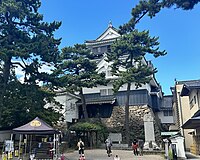History
Saigo Tsugiyori built an earthen-walled fortification in the Myodaiji area of Okazaki, near the present castle in 1455. Matsudaira Kiyoyasu, after gaining control of the area in 1524, demolished the old fortification and built Okazaki Castle on its present location. His famous grandson Matsudaira Motoyasu (later named Tokugawa Ieyasu) was born here on December 16, 1542. The Matsudaira were defeated by the Imagawa clan in 1549, and Ieyasu was taken to Sunpu Castle as a hostage. Following the defeat of the Imagawa at the Battle of Okehazama, Ieyasu regained possession of the castle in 1560 and left his eldest son Matsudaira Nobuyasu in charge when he moved to Hamamatsu Castle in 1570. After Oda Nobunaga ordered Nobuyasu’s death in 1579, the Honda clan served as castellans. Following the relocation of the Tokugawa to Edo after the Battle of Odawara by Toyotomi Hideyoshi, the castle was given to Tanaka Yoshimasa, who substantially improved on its fortifications, expanded the castle town and developed Okazaki-juku on the Tōkaidō.
Following the creation of the Tokugawa shogunate, Okazaki Domain was created, and Ieyasu’s close retainer Honda Yasushige was assigned possession of the castle. A three-story donjon was completed in 1617. The Honda were replaced by the Mizuno clan from 1645-1762, and the Matsudaira (Matsui) clan from 1762-1769. In 1769, a branch of the Honda clan returned to Okazaki, and governed until the Meiji Restoration.
In 1869, the final daimyō of Okazaki Domain, Honda Tadanao, surrendered Okazaki Castle to the new Meiji government. With the abolition of the han system in 1871, Okazaki Domain became part of Nukata Prefecture, with Okazaki Castle used as the prefectural headquarters. However, Nukata Prefecture was merged into Aichi Prefecture in 1872, and the capital of the prefecture was moved to Nagoya. In accordance with government directives in 1873, the castle was demolished, and most of its land sold off to private individuals.
The current donjon was reconstructed in 1959 to boost local tourism. In 2006, it was proclaimed one of the 100 Fine Castles of Japan. The ferroconcrete structure has three roofs and five interior floors, and contains exhibits of artifacts from the original castle, Japanese swords, armor and dioramas illustrating local history. The main gate of the castle was reconstructed in 1993, and the east corner yagura in 2010.
In 2007, construction work near the castle revealed stonework from the castle’s outer baileys, lending evidence to the claim that Okazaki Castle was once the fourth largest in Japan.
The remaining castle grounds are now a park, with a museum dedicated to the life of Tokugawa Ieyasu and the Mikawa samurai, teahouses, a Noh theater, a small clock tower with traditional karakuri puppets, as well as the reconstructed castle buildings and the remaining stonework and moats of the castle. The park is also renowned as a famous site for viewing cherry blossoms, wisteria and azalea. [1]

Karatsu Castle is a Japanese castle located in Karatsu, Saga Prefecture, Japan. It is a hirayamajiro, a castle built on a plain rather than a hill or mountain. At the end of the Edo period, Karatsu castle was home to the Ogasawara clan, daimyō of Karatsu Domain. It was also known as "Dancing Crane Castle".

Matsudaira Nobuyasu was the eldest son of Matsudaira Ieyasu. His tsūshō was Jirōzaburō (次郎三郎). He was also called "Okazaki Saburō", because he had become the lord of Okazaki Castle (岡崎城) in 1570. Because he was a son of Tokugawa Ieyasu, he is often referred to, retroactively, as Tokugawa Nobuyasu.
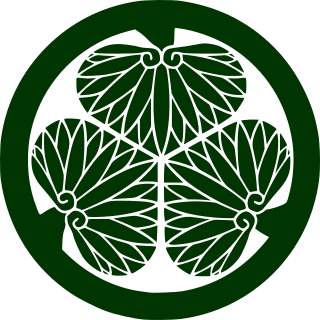
The Tokugawa clan is a Japanese dynasty which produced the Tokugawa shoguns who ruled Japan from 1603 to 1868 during the Edo period. It was formerly a powerful daimyō family. They nominally descended from Emperor Seiwa (850–880) and were a branch of the Minamoto clan through the Matsudaira clan. The early history of the clan remains a mystery. Nominally, the Matsudaira clan is said to be descended from the Nitta clan, a branch of the Minamoto clan, but the likelihood of this claim is considered quite low or untrue.

The Okazaki Domain encompassed the Mikawa Province, which is situated in what is now the eastern part of Aichi Prefecture. The administrative center of the domain was established within the walls of the historic Okazaki Castle. Due to its associations with Tokugawa Ieyasu, who was born in Okazaki Castle, the domain had a prestige greater than in its nominal valuation based on rice tax revenues.
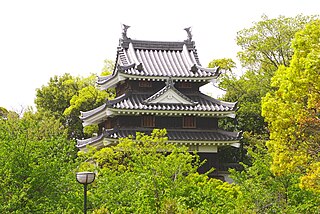
Nishio Domain was a feudal domain of the Tokugawa shogunate of Edo period Japan, located in former Mikawa Province, in what is now the modern-day city of Nishio in Aichi Prefecture, Japan. It was centered on Nishio Castle.
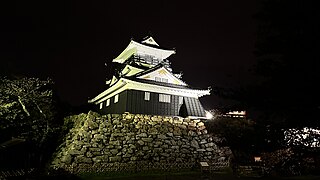
Hamamatsu Castle is a hirayama-style Japanese castle ruin, with some replica castle buildings. It was the seat of various fudai daimyō who ruled over Hamamatsu Domain, Tōtōmi Province, in what is now central Hamamatsu, Shizuoka Prefecture, Japan under the Edo period Tokugawa shogunate. It is also called Shusse Castle.

Sunpu Castle is a Japanese castle in Shizuoka City, Shizuoka Prefecture in Japan. The sobriquet of this feudal fortress was the "Castle of the Floating Isle". It was also referred to as Fuchu Castle or Shizuoka Castle.
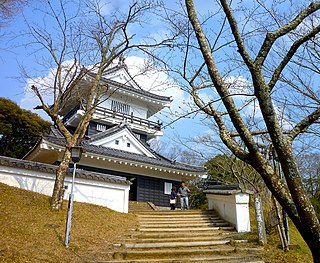
Kururi Castle is a Japanese castle located in Kimitsu, southern Chiba Prefecture, Japan. At the end of the Edo period, Kururi Castle was home to a branch of the Kuroda clan, daimyō of Kururi Domain. The castle was also known as Rain Castle, after a legend that it rained twenty-one times during its construction, or, on average, once every three days. It is located on a 227 meter hill.

Ōtaki Castle is a Japanese castle located in Ōtaki, southeast Chiba Prefecture, Japan. In the Edo period, Ōtaki Castle was given to Honda Tadakatsu. The castle was also known as "Odaki-jō" (小田喜城).
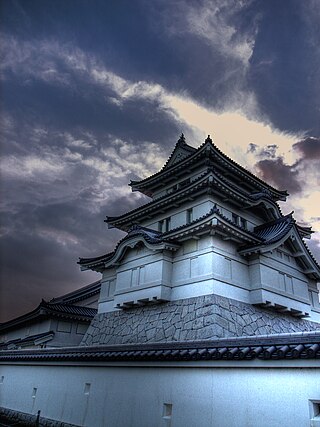
Sekiyado Castle is a Japanese castle located in Noda, northwestern Chiba Prefecture, Japan. At the end of the Edo period, Sekiyado Castle was home to the Kuse clan, daimyō of Sekiyado Domain.

Yoshida Castle is a Japanese castle located in Toyohashi, southeastern Aichi Prefecture, Japan. At the end of the Edo period, Yoshida Castle was home to the Inaba clan, daimyō of Tateyama Domain. The castle was also known as Imabashi Castle, and later as Toyohashi Castle.

Koromo Castle is a Japanese castle located in Toyota, Aichi Prefecture, Japan. At the end of the Edo period, Koromo Castle was home to the Naitō clan, daimyō of Koromo Domain. The castle was also known as Shichishū-jō (七州城).
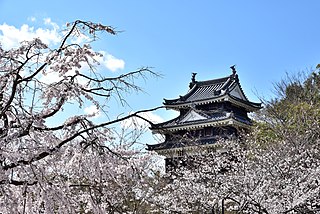
Nishio Castle is a Japanese castle located in the city of Nishio, eastern Aichi Prefecture, Japan. At the end of the Edo period, Nishio Castle was home to the Ogyu Matsudaira, daimyō of Nishio Domain. The castle was also known as Tsuru-jō (鶴城), Tsuruga-jō (鶴ヶ城), or Saijo-jō (西条城).

Tahara Castle is a Japanese castle located in Tahara, southern Aichi Prefecture, Japan. At the end of the Edo period, Tahara Castle was home to the Miyake clan, daimyō of the 12,000 koku Tahara Domain.

Tanaka Castle is a Japanese castle located in Fujieda, central Shizuoka Prefecture, Japan. At the end of the Edo period, Tanaka Castle was home to a branch of the Honda clan, daimyō of Tanaka Domain.

Lady Tsukiyama or Tsukiyama-dono was a Japanese noble lady and aristocrat from the Sengoku period. She was the chief consort of Tokugawa Ieyasu, the daimyō who would become the founder and first shōgun of the Tokugawa shogunate. She was the mother of Ieyasu's first child, Kamehime, and gave birth to Ieyasu's heir apparent, Matsudaira Nobuyasu. As principal consort, Tsukiyama led many of the political achievements of the former Matsudaira clan. She was an important figure at the beginning of Ieyasu's career, who later led to the beginning of Tokugawa Shogunate. She is best known for possibly initiating a conspiracy against Oda Nobunaga. Whether or not she cheated Ieyasu into joining the Takeda clan; the veracity of this event remains one of the greatest mysteries of the Sengoku period, known as the Nobuyasu Incident.
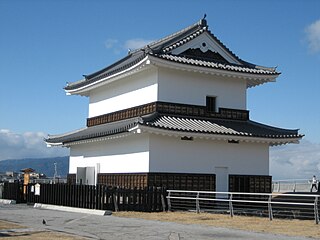
Kuwana Castle is a Japanese castle located in Kuwana, northern Mie Prefecture, Japan. At the end of the Edo period, Kuwana Castle was home to a branch the Matsudaira clan, daimyō of Kuwana Domain. The castle was also known as "Ōgi-jō" (扇城) or "Asahi-jō" (旭城).
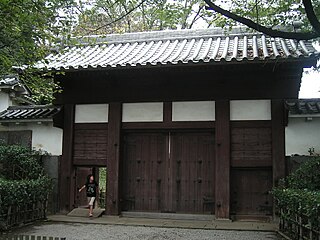
Tatebayashi Castle is a Japanese castle located in Tatebayashi, southern Gunma Prefecture, Japan. At the end of the Edo period, Tatebayashi Castle was home to the Akimoto clan, daimyō of Tatebayashi Domain, but the castle was ruled by a large number of different clans over its history. The castle was also known as "Obiki-jō" (尾曳城).

Kasama Castle is a Japanese castle located in Kasama, central Ibaraki Prefecture, Japan. At the end of the Edo period, Kasama Castle was home to a junior branch of Makino clan, daimyō of Kasama Domain, but castle and domain went through many changes in clans during the early Edo period.
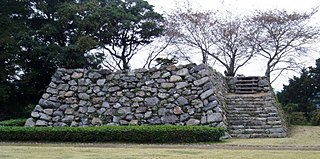
Futamata Castle was a Japanese castle located in Toyoda county of Tōtōmi Province, in what is now part of Tenryū-ku in the city of Hamamatsu, Shizuoka Prefecture, Japan. It was built in the Sengoku period and is noted as the site of the death of Tokugawa Ieyasu's son Matsudaira Nobuyasu in 1579. In 2018, the ruins were recognized as a National Historic Site together with adjacent Tobayama Castle.
